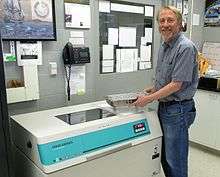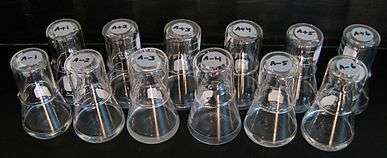Richard Lenski
| Richard Lenski | |
|---|---|
 Richard Lenski with Long-Term Flasks and Incubator on May 26, 2016 | |
| Born | August 13, 1956 |
| Fields | Evolutionary biology Experimental evolution |
| Institutions |
Michigan State University University of California, Irvine |
| Alma mater |
University of North Carolina, Chapel Hill Oberlin College |
| Thesis | Effects of competition and disturbance on ground beetle populations (1982) |
| Known for | E. coli long-term evolution experiment |
| Notable awards |
Sewall Wright Award (2012) MacArthur Fellowship (1996) |
|
Website | |
Richard E. Lenski (born August 13, 1956) is an American evolutionary biologist,[1] best known for his 28-year long-term E. coli evolution experiment, and his work with digital organisms, using Avida.
Early life
Richard E. Lenski is the son of sociologist Gerhard Lenski and poet Jean Lenski (née Cappelmann).[2] He is also the great-nephew of children's author Lois Lenski and the great-grandson of Lutheran commentator Richard C. H. Lenski. He earned his BA from Oberlin College in 1976, and his PhD from the University of North Carolina in 1982.[3]
Career
Lenski won a Guggenheim Fellowship in 1992 and a MacArthur Fellowship in 1996, and in 2006 he was elected to the United States National Academy of Sciences.
Lenski is a fellow at the American Academy of Microbiology and the American Academy of Arts and Sciences and holds the office Hannah Distinguished Professor of microbial ecology at Michigan State University. Lenski has an Erdős number of 3, having co-authored a publication with a mathematician and a computational biologist, each of whom has an Erdős number of 2.[4]
On February 17, 2010, he co-founded the NSF Science and Technology Center for the Study of Evolution in Action, known as the BEACON Center.
E. coli experiment

The E. coli long-term evolution experiment is an ongoing study in experimental evolution led by Richard Lenski that has been tracking genetic changes in 12 initially identical populations of asexual Escherichia coli bacteria since 24 February 1988.[5] The populations reached the milestone of 50,000 generations in February 2010.
Since the experiment's inception, Lenski and his colleagues have reported a wide array of genetic changes; some evolutionary adaptations have occurred in all 12 populations, while others have only appeared in one or a few populations. One particularly striking adaptation was the evolution of a strain of E. coli that was able to use citrate as a carbon source in an aerobic environment.[6]
Avida simulation
Richard Lenski, Charles Ofria, et al. at Michigan State University developed an artificial life computer program with the ability to detail the evolution of complex systems. The system uses values set to determine random mutations and allows for the effect of natural selection to conserve beneficial traits. The program was dubbed Avida and starts with an artificial petri dish where organisms reproduce and perform mathematical calculations to acquire rewards of more computer time for replication. The program randomly adds mutations to copies of the artificial organisms to allow for natural selection. As the artificial life reproduced, different lines adapted and evolved depending on their set environments. The beneficial side to the program is that it parallels that of real life at rapid speeds.[7][8][9][10]
Media
In August 2013, having been inspired by a presentation by Titus Brown on the role of social media in science, Lenski began blogging at Telliamed Revisited and tweeting as @RELenski.[11]
Lenski's research has received considerable attention, including lengthy discussion in Carl Zimmer's book on E. coli, Microcosm, and in Richard Dawkins' book on the evidence for evolution, The Greatest Show on Earth. Included in Dawkins' discussion was a description of the dialog Lenski had in 2008 with Andrew Schlafly, creator of Conservapedia, which Schlafly initiated as a reaction to reports of Lenski's description of the evolution of aerobic citrate usage in one of the long-term evolution experiment populations. These same findings were later cited by the creationist Ken Ham in a debate over evolution with Bill Nye. Lenski strongly criticized Ham's citation of his work and the conclusions Ham drew from it.[12]
References
- ↑ "Richard Lenski". Michigan State University. 2008. Retrieved 2008-09-17.
- ↑ Richard Lenski [relenski] (August 17, 2014). "Photo of Richard Lenski and Gerhard Lenski for the father's 90th birthday" (Tweet). Retrieved August 18, 2014 – via Twitter.
- ↑ Campbell, Neil A.; Reece, Jane B. Biology (7 ed.). pp. 538–539. ISBN 0-8053-7146-X.
- ↑ Richard Lenski (May 28, 2015). "Erdös with a non-kosher side of Bacon".
- ↑ Lenski, Richard E. (2000). "Source of founding strain". Richard E. Lenski Homepage. Michigan State University. Retrieved 2008-06-18.
- ↑ Blount, Zachary D.; Borland, Christina Z.; Lenski, Richard E. (2008). "Historical contingency and the evolution of a key innovation in an experimental population of Escherichia coli". Proceedings of the National Academy of Sciences. 105 (23): 7899–906. Bibcode:2008PNAS..105.7899B. doi:10.1073/pnas.0803151105. JSTOR 25462703. PMC 2430337
 . PMID 18524956.
. PMID 18524956. - ↑ Lenski, R. E.; Ofria, C.; Pennock, R. T.; Adami, C. (2003). "The evolutionary origin of complex features" (PDF). Nature. 423 (6936): 139–144. Bibcode:2003Natur.423..139L. doi:10.1038/nature01568. PMID 12736677.
- ↑ "Digital organisms used to confirm evolutionary process". American Association for the Advancement of Science. Retrieved 2011-03-21.
- ↑ "Artificial life experiments show how complex functions can evolve". American Association for the Advancement of Science. Retrieved 2011-03-21.
- ↑ Richard E. Lenski; Charles Ofria; Claus O. Wilke; Jia Lan Wang & Christoph Adami (2001-07-19). "Evolution of digital organisms at high mutation rates leads to survival of the flattest". Nature. 412 (6844): 331–3. Bibcode:2001Natur.412..331W. doi:10.1038/35085569. PMID 11460163.
- ↑ Richard Lenski (August 19, 2013). "Welcome to Telliamed Revisited".
- ↑ https://telliamedrevisited.wordpress.com/2014/02/05/ham-on-nye-debate-follow-up-1/, https://telliamedrevisited.wordpress.com/2014/02/06/ham-on-nye-debate-follow-up-2/, https://telliamedrevisited.wordpress.com/2014/02/07/zachary-blount-on-ham-on-nye-debate-follow-up-3/
External links
- E. coli Long-term Experimental evolution site
- BEACON Center for the Study of Evolution in Action
- News release from Michigan State University
- The Loom : A New Step In Evolution